ARMY NEWS
SPECIAL REPORT: The 24 Programs the Army Promised to Expedite: Part Five — Training and Simulation, Night Vision
By National Defense Staff
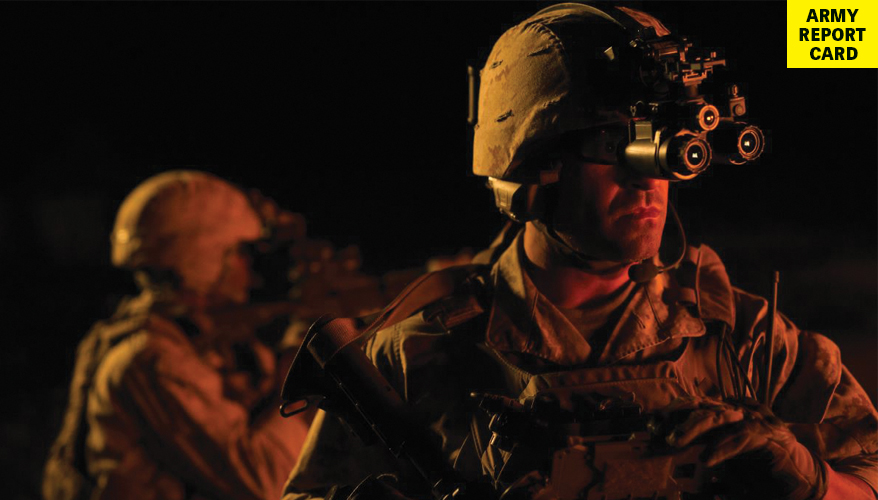
Illustration with Army photo, iStock illustration
In October 2021 then Army Chief of Staff Gen. James McConville vowed to put 24 key technologies “in the hands of soldiers” by the end of fiscal year 2023.
Now that the deadline has passed, National Defense in this special report looks at each of the 24 technologies and assigns them a letter grade based on how close the Army got to fielding the systems. See the end of the article on how the 24 programs were graded.
Part One: Fires, Long-Range and Short
Part Five: Training and Simulation, Night Vision
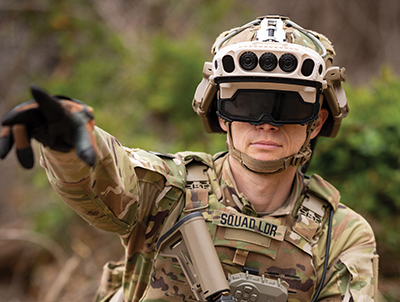
INTEGRATED VISUAL
AUGMENTATION SYSTEM
Former Army Chief of Staff Gen. James McConville called the Integrated Visual Augmentation System “one of the most transformational capabilities for our soldiers on the battlefield.” But poor performance in testing has made the Army question whether the system will ever see the field.
Developed by Microsoft, the system — nicknamed IVAS — is a mixed reality headset meant to enhance soldiers’ “battlefield awareness and ability to rapidly identify potential threats and take decisive action,” according to the Program Executive Office Soldier website.
The Army conducted an operational test with IVAS 1.0 in June 2022, and soldiers indicated the system was unreliable, had poor low-light performance and an awkward form factor, a January 2023 Director, Operational Test and Evaluation report stated.
In November 2022, the Army and Microsoft “incorporated a new software release into IVAS 1.0 resulting in a more stable and reliable user experience,” a service release said. The Army accepted delivery of 5,000 IVAS 1.0 systems to be used by training and doctrine units, and in December ordered 5,000 units of IVAS 1.1, which “upgrades reliability and features an improved low-light sensor.”
The Army also in December awarded Microsoft a task order for IVAS 1.2, which would be fielded to operational units as early as the fourth quarter of fiscal year 2025, the release said. “The majority of the close combat force will receive IVAS 1.2; this version features an improved form factor in addition to reliability and low-light sensor upgrades, as well as a lower profile heads-up display with distributed counterweight for improved user interface and comfort,” the release said.
Microsoft delivered 20 IVAS 1.2 prototypes to the service in late July for a user assessment to measure system performance and “to ensure engineering efforts are on schedule and meeting design objectives,” a PEO Soldier spokesperson said in an email. “The Army plans to consider a full-rate production decision at the conclusion of a scaled operational test in” fiscal year 2025.
During testimony before Congress in April, Assistant Secretary of the Army for Acquisition, Logistics and Technology Doug Bush made it clear IVAS is on thin ice.
“Microsoft, they have to deliver,” Bush said. “This 1.2 system needs to be exactly what the Army needs, or we are not going to produce it.” — Josh Luckenbaugh
The goggles have had many “soldier touchpoints,” it’s just that the users don‘t like what they are seeing. Even if the program turns itself around, it would be long past the fiscal year 2023 deadline. Grade: C-.
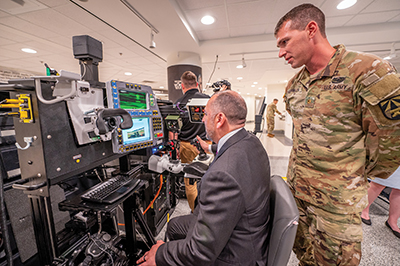
RECONFIGURABLE VIRTUAL
COLLECTIVE TRAINER
It’s a Bradley. It’s a Stryker. It’s an Abrams. Currently, the Reconfigurable Virtual Collective Trainer ground platforms, or RVCT-G, can be configured as any of those vehicles in roughly an hour, and the aviation version, or RVCT-A, can be a Black Hawk, Apache or Chinook helicopter.
Eventually, the Army wants the portable trainers to simulate nine ground and six aircraft platforms for use in collective training.
During a July event at the Pentagon, the Army demonstrated the trainers configured as an Abrams and Black Hawk. Maj. Lane Berg, materiel developer for Program Executive Office Simulation, Training and Instrumentation, said: “The true power behind this system as a whole is the collective training aspect. So, it’s the tank being able to talk to the aircraft over there.” And that kind of multi-domain training is expensive and often difficult to replicate live, he said.
Soldiers emphasized the systems are not designed for exquisite training — landing a helicopter or firing tank weapons — but collective and combined arms training in the Army’s Synthetic Training Environment. Army officers said the RVCT has gone through more than 60 soldier and subject matter expert touchpoints that have led to the hardware being well refined.
“We have had a lot of feedback, and we correct or improve the system nearly monthly,” Berg said.
On the software side, there are still stability problems and bugs to work out, officers said. “The software’s in the development process,” Berg said. “So, it’s a prototype right now.”
The Army awarded Cole Engineering Services a $500 million Other Transaction Authority contract in May to begin hardware production. An operational demonstration is scheduled for the second quarter of fiscal year 2024 with first unit equipped the following quarter, a PEO spokesperson said. — Sean Carberry
The contractor is still working on delivering the final versions and the system is still in the prototype phase, earning it a B grade.
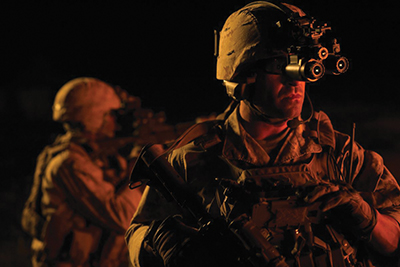
ENHANCED NIGHT VISION
GOGGLE-BINOCULAR
Army units are saying goodbye to the green glow of legacy night vision goggles as the service fields the Enhanced Night Vision Goggle-Binocular, which employs white phosphorus tubes to achieve no- and low-light visibility in a heads-up display.
The helmet-mounted goggles improve upon previous technology with image intensification, infrared (thermal) sensors, wireless connectivity through intra-soldier wireless and augmented reality enhancements, an Army fact sheet stated.
The thermal technology allows ENVG-B to see through smoke, dust or fog. “This thermal capability makes ENVG-B useful during the day as well as at night, unlike earlier night vision devices,” the fact sheet stated.
ENVG-B also integrates with the Family of Weapon Sights-Individual, which “provides a passive target acquisition capability that enables the soldier to fire quickly from almost any position without having to shoulder the weapon, therefore increasing soldier survivability,” a spokesperson for Program Executive Office Soldier said in an email.
In addition, ENVG-B has augmented reality capabilities to display navigational information, blue force tracking and tagging of items and locations when connected wirelessly to Nett Warrior, the spokesperson said.
Elbit Systems of America and L3Harris Technologies each received Other Transaction Authority contracts for low-rate production in 2020, with maximum potential values of $442 million. Under the contracts, the companies are producing identical products in Roanoke, Virginia, and Londonderry, New Hampshire, respectively.
The Army completed Critical Design Review and Operational and First Article tests in 2021, and First Unit Equipped in 2022. Fielding is ongoing, the spokesperson added. PEO Soldier did not provide data on how many units have been delivered, but public statements from the vendors indicate it is in the tens of thousands. — Sean Carberry
The Army had already fielded the system when McConville made his 24-by-23 declaration, so this was a “gimme” for the service. It probably shouldn’t’ have been on the list, but there is no rule against it, so A+.
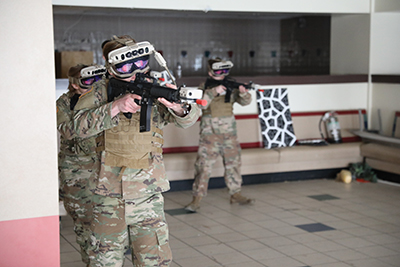
VIRTUAL TRAINER
The Army’s Squad Immersive Virtual Trainer, or SiVT, is designed to enable small unit training of common battle drills in a mixed reality-based synthetic environment, according to a Program Executive Office for Simulation, Training and Instrumentation fact sheet.
SiVT will “permit training scenarios to be quickly and easily developed and modified by warfighters to suit specific training requirements and capture performance data and provide an after action review capability,” it stated.
Furthermore, because the trainer uses a visor system, it will allow soldiers to train at the “point of need,” it said.
Other promises of SiVT noted on the fact sheet include: integrating organic squad weapons virtual training for force on force and on virtual target; biometric and advanced human performance data collection and analysis; and artificial intelligence/machine learning “for thinking and learning opposing force and performance analytic tools.”
There’s just one problem: SiVT operates on the fraught Integrated Visual Augmentation System, or IVAS.
To date, the Microsoft-designed IVAS has been one of the most problematic of the 24-by-23 technologies, as the initial design met with withering criticism from soldiers. The Army is currently experimenting with the redesigned IVAS 1.2 in hopes the updated visor, software, sensors and form factor will deliver augmented reality capabilities without the weight and disorientation that troubled soldiers testing the original version.
A March 2023 Army news article stated soldiers have provided positive feedback on training simulations they have conducted with SiVT, indicating IVAS might be able to meet virtual training needs, at least.
SiVT relies on the Training Simulations Software, One World Terrain and the Training Management Tool applications, which have completed several soldier touchpoints and are scheduled for fielding in fiscal year 2024.
The Program Executive Office for Simulation, Training and Instrumentation said in an email, “SiVT testing, user assessments and data collection are ongoing,” and first unit equipped is planned for the first quarter of 2026.
That assumes IVAS moves forward. As noted in the writeup for that program, if IVAS 1.2 does not meet expectations, the Army is dropping it. — Sean Carberry
With all the uncertainty surrounding the program, and first unit equipped not expected until far beyond the 24-by-23 deadline, the best grade it could receive is a C-.
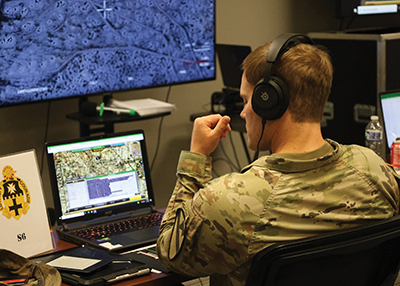
TRAINING MANAGEMENT TOOLS/
ONE WORLD TERRAIN
While most of the 24-by-23 modernization programs are physical — missiles or vehicles — one major priority is virtual: the Synthetic Training Environment, the digital universe enabling the Army’s live, virtual and constructive training.
Within the STE are three pieces of software that enable collective training, Col. Nick Kioutas, its project manager, said during a July demonstration at the Pentagon.
First is the Training Simulation Software, or TSS, “the capability that replicates a synthetic environment,” he said. The Training Management Tool, or TMT, “is the interface for the soldiers to operate the study that allows them to plan, prepare, execute and assess the training.”
Third is One World Terrain, or OWT, which “replicates real life terrain so that soldiers can not only train on realistic terrain, but even do rehearsals on terrain that they might be fighting on in the future,” he added.
The Army has been conducting soldier touchpoints, and fielding is slated for fiscal year 2024, he said.
“The soldiers that we’ve done soldier touchpoints with, they’ve really shown us some things that we didn’t even think of,” he said. “But I think the more that capability gets out there, and they can facilitate setting up quick, easy training, it will expand the opportunities that we find.”
As these are software tools, there is no end state or initial operating capability. “We kind of have a destination. But how we get there we keep changing based on soldier feedback and prioritization of that feedback.”
Cole Engineering Services Inc. — which is the contractor for the related Reconfigurable Virtual Collective Trainer — is the contractor for TSS and TMT, and Maxar Technologies is the contractor for OWT. All three are under Other Transaction Authority agreements, executing within the Software Acquisition Pathway and have achieved “minimal viable capability release” in fourth quarter fiscal year 2021, a spokesperson for Program Executive Office Simulation, Training and Instrumentation said in an email.
The adaptive pathways and soldier touchpoints have “allowed the project manager to prioritize development activities to accelerate fielding of useful capability at the earliest possible moment,” the spokesperson added. — Sean Carberry
A largely software enabled program is a different animal than the mostly hardware-based technologies found on the rest of this list. A “minimal viable capability release,” followed by soldier touchpoints, sounds like a prolonged test-and-evaluation period, thus earning it an A-.
National Defense’s Grading System
A-plus — Initial operating capability or first unit fielded. Must be “in the hands of enough soldiers” to where it could make an impact if the Army were asked to go to war on Oct. 1, 2023.
The editor in chief assigned the letter grades based on the reporters’ findings and after conferring with the managing editor. The final decision on the grade was the editor in chief’s alone, and criticism, feedback and general disagreements should be directed his way.
Topics: Army News
